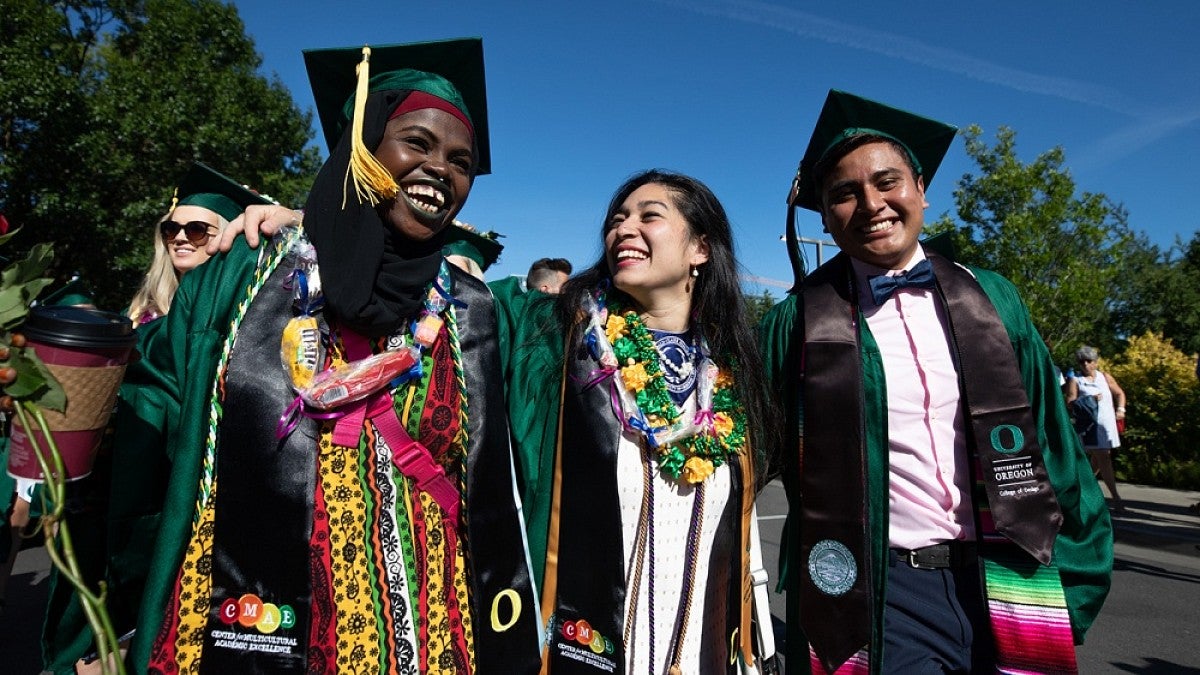Graduation rates at the University of Oregon have reached an all-time high, with 60.7 percent of students graduating in four years and 74.4 percent of students graduating in six years.
In 2014, the four-year graduation rate was 49.9 percent. That rate has increased significantly in the last five years, with this year’s percentage climbing 3.3 points over last year’s rate. The news was similarly notable for UO’s student athletes, who achieved their highest Graduation Success Rate ever with 86 percent graduating within six years.
“It is uncommon for graduation rates to increase this quickly,” said Vice Provost Doneka Scott, who leads the Division of Undergraduate Education and Student Success. “Our ability to break down institutional silos and collaborate across campus in a student-centered fashion has had a tremendous impact on improving our students’ experiences and success outcomes.”
Scott added that the devotion of partners across campus to work across divisions in the best interest of students has been a major contributor to the rise in graduation rates. She highlighted the efforts of faculty members, the campuswide advising community, residential education practitioners, academic and student support staff, and counseling services, as well as the colleges, schools and divisions of Equity and Inclusion, Global Engagement, Student Life, Student Services and Enrollment Management, and Undergraduate Education and Student Success.
Upon his arrival at the university in 2015, President Michael H. Schill launched a number of student success initiatives and challenged the campus community to help improve the four-year graduation by 10 percentage points by 2020. Scott was brought in to lead the student success initiative, with a goal to remove barriers to on-time graduation and support efforts to enhance the student experience.
Schill said he is very pleased the university met the goal a year ahead of schedule.
“This achievement would not have been possible without the commitment of the entire UO community,” the president said. “Through our investment of resources and the tireless work of dedicated individuals across campus, we are helping more students thrive and graduate. Our students are saving time and money, and are better prepared for great careers after graduation. I congratulate and thank Vice Provost Scott, her division, faculty, advisors and the entire campus community for this achievement.”
Since 2016, nearly 20 student success initiatives have been implemented, specifically aimed at reducing institutional barriers to timely graduation and ensuring all students are well-supported in their pursuit of a degree.
A few of the initiatives implemented include:
- Launching the “Finish in Four” and “On Track, On Time” campaigns, publicizing the institutional desire and expectation that students complete their degrees in a timely fashion.
- Implementing a first-year live-on requirement, which is a best practice contributing to an increase in first to second-year retention.
- Revising curricular policies such major declaration and course repeat policies, revitalizing the Core Education and multicultural requirements, improving course sequencing and availability, and eliminating noncredit remedial math courses and launching a new math placement exam and policy.
- Expanding undergraduate research opportunities and augmenting academic support services.
- Hiring more than 30 new advisors across campus to reduce the student-to-advisor ratio and implementing new platform software, Navigate/SSC campus, to better track student advising and coordinate advisors across campus.
- Increasing the number and type of first-year experiences for incoming students.
Recent graduate Adriane Hershey has no doubts the resources and support she received while attending the University of Oregon helped her graduate in four years.
Hershey graduated in June with an advertising degree and now works as a social media coordinator for an advertising agency in Portland. She says her involvement in a first-year experience, meeting with an advisor before registering for classes each term and working on-campus were keys to her on-time graduation.
“Being involved during my first term as a freshman helped me develop a comfortability and familiarity with the campus that I don’t think I would have developed on my own,” Hershey said. “It also helped, coming to a big campus like the UO, to have a little community waiting for me that I could feel comfortable in.”
Hershey, who worked on campus throughout college, said she drew from things she learned in her first-year experience to help her as she got closer to graduation.
“Later in my college career, when I was really busy working three jobs and taking a full load of classes, having connections to campus and knowing skills such as how to use the library, how to do research, things like that, made me feel more well-equipped to handle challenges that came my way,” Hershey said.
Academic and social integration — such as engagement with faculty inside and outside of the classroom, undergraduate research opportunities, co-curricular activities and first-year experiences — are key components of students’ success on campus, Scott said.
The next phase of student success initiatives is now being implemented and will center around institutionalizing the campus’ student success guiding principles, ensuring that everyone on campus sees how their work aligns with the campus definition of student success. The goal is to ensure UO students will graduate having had a positive experience and will be well educated, socially responsible and career ready.
—By Kim Lamke Calderón, University Communications


